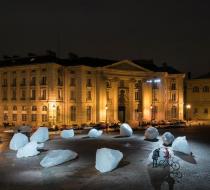Air Pollution Favorite
An artist who sparked significant awareness regarding the issues of climate change was Olafur Eliasson. Eliasson’s main objective has been to catch people’s attention and make them feel emotions and care about climate change because many people do not connect to the effects of climate issues as they do with other controversial impacts solely because the effects are not played out directly in front of them. Many of his pieces resonate with environmental or social issues and demonstrate the collaboration between art and activism. Eliason once said in an interview that “The incomprehensible scale of the loss due to warming of the Arctic is the very reason why the problem has to be addressed and public awareness must be raised (Huff post).”
An example of one his works that personifies the impacts of climate change is the project Ice Watch which was showcased in multiple cities including Copenhagen, Paris and London. This project consisted of chunks of glacier ice being positioned into Eliasson’s art work which exemplified social engagement as it is was placed within the community so that it could be experienced by everyone. The positioning of ice pieces into a clockwise pattern was an interesting element that symbolizes time and perhaps running out of time to save our environment and planet. His selection of imported big blocks of ice melting in the city squares was an articulation of art and activism. The importance and purpose of his work is to serve beyond a visual reminder of the environmental changes that cannot be missed or ignored. Simply put, his work is “a representation of the amount of ice that disappears every hundredth of a second due to conditions of global warming (Huff post).”
The Ice Watch was a very interactive project that was also physical and activates all the senses so that people can also smell, touch, and hear it. His project was designed to “give feelings to things that are otherwise unemotional and encourage the “big players, the state, but also the private sector and large companies” to act (Yalcinkaya).” Eliasson makes the problem less abstract because the project is visually appealing and attention grabbing, plus it is displayed directly in the presence of their eyes, as opposed to seeing it through photographs or videos. This interaction forms an experience that makes it more relatable to the audience and for the people to understand and comprehend how rapid the change is because they can see and hear the ice melting in their city, or in the midst of their daily routine, not just somewhere in the artic or northern hemisphere. Consequently, this creates a connection and develops emotions due to the unsettling reality of something much bigger than it is but is simply a small-scale result of climate change.
Eliasson was strategic in choosing to let people watch the ice melt, instead of taking it away, because the social engagement amplifies the attitudes and perceptions of the environmental issues. You can also hear the crisp noise of the ice cracking while desolidifying and in doing so, the melting process releases pressure that has been held within the ice for years. The smell of the ice block is from decades back when the co2 got trapped in the ice, and this then releases a fresh scent of the purity of the air and how it could have been preserved if all the negative environmental disruptions had received attention sooner. Overall, this sensory stimulation and experience resulted in a positive reaction from the community because it provided a deeper sense of awareness about the environmental message in relation to social engagement.







